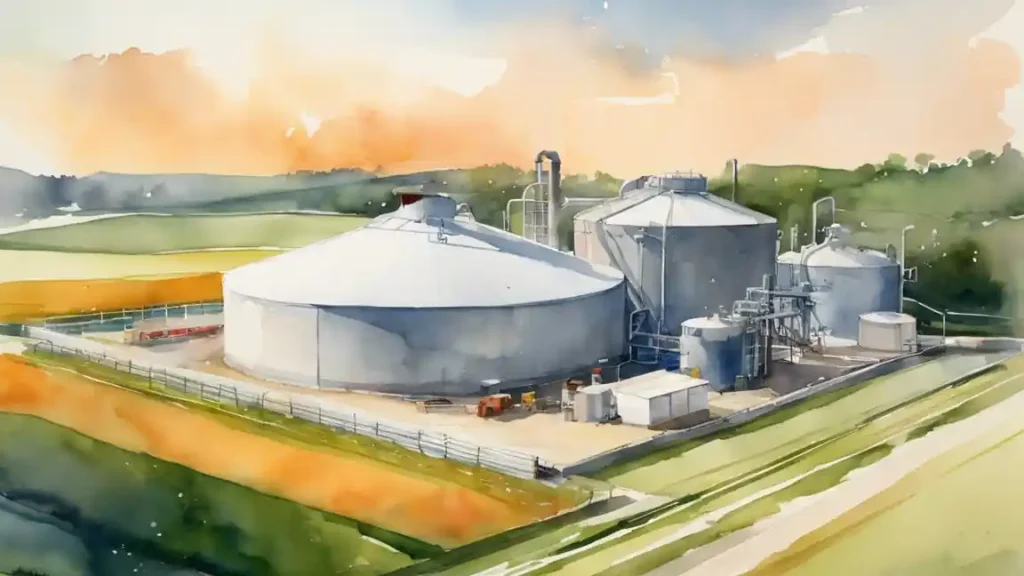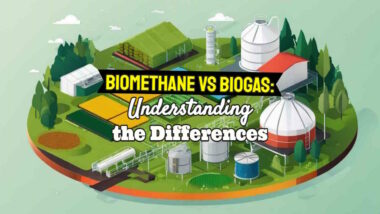FOS/TAC Anaerobic Digestion process control combines all the important health indicators for a biogas plant's optimum day-to-day operational adjustments based on the best science. FOS/TAC measurement provides operators with an optimum target ratio to achieve the most stable digester at optimum biogas yield. It costs a bit more to measure than alkalinity, but the technology is available and well-tested, you get advanced warning of trouble ahead in time to avoid it, and the payback is rapid. This is especially so for digesters that are fed below their capacity to avoid the risks of acidosis.
Read this article and see whether you can still justify using anything less?
[boomdevs_toc]
An Introduction to FOS/TAC Anaerobic Digestion Process Measurement
As the world shifts towards sustainable solutions for waste management, anaerobic digestion has emerged as a promising technology for organic waste treatment. However, to harness the full potential of anaerobic digestion systems, it is crucial to optimize each digester for optimum biogas yield and stability.
With increased reliance on AD plants as a primary 24/7 energy source it has become vital to avoid biogas slowdowns, let alone a sour reactor out of operation for a number of weeks.
The solution is FOS/TAC anaerobic digestion process control. FOS/TAC is a widely accepted method for monitoring the anaerobic digestion process and controlling the feeding rate of organic matter to maintain optimal conditions.
In this article, we will provide a comprehensive overview of FOS/TAC anaerobic digestion process control and its significance in achieving efficient biogas production and waste reduction. We will discuss the anaerobic digestion process, its key stages, and the role of FOS/TAC measurement in controlling the process. Furthermore, we will explore the common challenges associated with biogas plant operation that are alleviated by FOS/TAC control and provide strategies and best practices for optimized control.
FOS/TAC Anaerobic Digestion Process Measurement – Key Takeaways:
- The FOS/TAC method is crucial for monitoring and controlling the anaerobic digestion process.
- The optimal FOS/TAC levels facilitate efficient biogas production and waste decomposition.
- Common challenges in FOS/TAC control include fluctuations in feedstock composition and wastewater characteristics.
- Strategies for optimizing FOS/TAC anaerobic digestion process control include feedstock management, pH adjustment, and temperature control.
- Best practices for FOS/TAC control in anaerobic digestion processes cover system design, operational parameters, and maintenance.

Understanding the Anaerobic Digestion Process
The anaerobic digestion process is a complex series of biological reactions that occur in the absence of oxygen and involve a range of microorganisms. This natural process breaks down organic matter, such as food waste, animal manure, and sewage sludge, into simpler compounds, such as carbon dioxide, water, and methane gas, which can be used for energy production and agricultural purposes.
There are several key stages in the anaerobic digestion process:
| Stage | Description |
|---|---|
| Hydrolysis | The breakdown of complex organic compounds, such as proteins, carbohydrates, and lipids, into simpler compounds by enzymes. |
| Acidogenesis | The conversion of simple compounds into organic acids, such as lactic acid, acetic acid, and propionic acid, by acidogenic bacteria. |
| Acetogenesis | The conversion of organic acids into acetic acid, hydrogen, and carbon dioxide by acetogenic bacteria. |
| Methanogenesis | The conversion of acetic acid, hydrogen, and carbon dioxide into methane gas and carbon dioxide by methanogenic archaea. |
The anaerobic digestion process is an attractive alternative to traditional waste management methods, such as landfilling and incineration, as it offers numerous environmental benefits, including reduced greenhouse gas emissions, decreased reliance on fossil fuels, and improved soil health.
Introduction to FOS/TAC Measurement
The FOS/TAC ratio is the best parameter for monitoring and controlling the anaerobic digestion process. It combines the most important chemical/physical parameters affecting the microorganisms and provides insights into microbial activity and substrate availability, indicating the potential for biogas production and waste decomposition efficiency. Therefore, accurate FOS/TAC measurement is crucial for optimizing anaerobic digestion process control.
What is the FOS/TAC Ratio?
The FOS/TAC ratio is the molar ratio of the concentration of free organic acids (FOS) to the sum of the concentration of total inorganic carbon (TIC) and the concentration of bicarbonate (HCO3-), which represents the buffering capacity of the system. FOS/TAC measurement is usually conducted by analyzing the pH, alkalinity, and volatile fatty acids (VFAs) concentration in the anaerobic reactor or feedstock.
pH Measurement
pH measurement is a straightforward and commonly used method for assessing FOS/TAC. At optimum conditions, the pH of anaerobic digestion should be maintained between 6.8 and 7.4. A substantial decrease in pH, below 6.5, may indicate an accumulation of VFAs and a drop in the FOS/TAC ratio, leading to process inhibition and decreased biogas production.
Alkalinity Measurement
Alkalinity is a measure of the buffering capacity of the anaerobic digestion system. It represents the system's ability to maintain a stable pH in the presence of acid-producing bacteria. In the anaerobic digestion process, the total alkalinity is composed of bicarbonate (HCO3-) and carbonate (CO32-) ions. The alkalinity is usually measured as mg/L of calcium carbonate (CaCO3) equivalent using titration methods.
VFA Concentration Measurement
The concentration of VFAs in the anaerobic reactor can also provide an indication of FOS/TAC. The VFAs, including acetic, butyric, and propionic acids, are intermediates of the organic matter degradation process and essential substrates for methanogenic archaea during biogas production. By monitoring the concentration of VFAs in the reactor, it is possible to predict changes in the FOS/TAC ratio, process stability, and biogas production.
Overall, FOS/TAC measurement is a critical aspect of anaerobic digestion process control. By understanding the methods and significance of FOS/TAC measurement, operators can optimize the process parameters to achieve maximum biogas production and waste treatment efficiency.
Importance of FOS/TAC Control in Anaerobic Digestion
The FOS/TAC ratio is a crucial parameter that directly impacts biogas production and organic waste decomposition in anaerobic digestion systems. A stable and optimal FOS/TAC level is essential for maintaining a healthy microbial community and preventing process failures. FOS stands for “food to microorganism ratio,” while TAC stands for “total anaerobic capacity.”
The FOS/TAC ratio is currently the best scientific indicator of the available substrate to the microorganisms in the anaerobic digester. When the ratio is too high, there is a risk of accumulation of volatile fatty acids, leading to acidification and inhibition of methanogenic bacteria. On the other hand, when the ratio is too low, the system fails to reach its maximum biogas potential, leading to reduced biogas yield and organic matter degradation.
Effective FOS/TAC control is, therefore, critical for improving process stability, maximizing biogas production, and minimizing waste. By maintaining optimal FOS/TAC levels, operators can ensure that the microbial community thrives, organic waste is effectively broken down, and high-quality biogas is produced.
Benefits of Maintaining Optimal FOS/TAC Levels
The benefits of maintaining optimal FOS/TAC levels in anaerobic digestion processes include:
- Increased biogas production
- Improved organic waste decomposition
- Reduced process instability and failure
- Enhanced process efficiency and productivity
- Reduced operating costs
- Reduced environmental impact
Impact of FOS/TAC Imbalance on Anaerobic Digestion
Imbalances in FOS/TAC levels can have significant negative impacts on anaerobic digestion processes. When the FOS/TAC ratio is too high, the microbial community produces excessive amounts of volatile fatty acids, leading to acidification and inhibition of methanogenic bacteria. This can result in a reduction in biogas yield, decreased organic matter degradation, and an increased risk of process failure.
When the FOS/TAC ratio is too low, the microbial community cannot fully utilize the available substrate, resulting in reduced biogas production and suboptimal organic matter degradation. This can lead to the accumulation of organic matter, which can cause process instability and failure.

FOS/TAC Control Strategies
Several strategies can be employed to optimize FOS/TAC control in anaerobic digestion processes, including:
- Feedstock management: Ensuring a consistent and balanced feedstock supply to maintain optimal FOS/TAC ratios.
- pH adjustment: Controlling pH levels to maintain optimal microbial activity and prevent process inhibition.
- Temperature control: Maintaining optimal operating temperatures for efficient microbial activity and biogas production.
- Hydraulic retention time (HRT) control: Adjusting the HRT to maintain optimal FOS/TAC ratios and avoid process instability.
- Codigestion: Codigesting high-FOS feedstock with low-FOS feedstock to maintain optimal FOS/TAC ratios.
By adopting these strategies, operators can ensure that the FOS/TAC ratio remains within optimal ranges, leading to improved process stability, productivity, and profitability.
Common Challenges in FOS/TAC Control
While FOS/TAC control is essential for ensuring optimal anaerobic digestion process performance, it can be challenging to manage. Here are some of the common challenges associated with FOS/TAC control:
Fluctuations in Feedstock Composition
One of the primary challenges in FOS/TAC control is the variation in feedstock composition. Different organic materials have varying levels of FOS and TAC, which can influence the overall anaerobic digestion process performance. If the FOS/TAC ratio is not maintained correctly, it can lead to process instability, reduced biogas production, and even system failure.
Wastewater Characteristics
Another common challenge is the changing characteristics of wastewater, which can also affect FOS/TAC levels. Factors such as pH, temperature, and nutrient content can alter the microbial population in the anaerobic digester and impact the FOS/TAC balance. High levels of inhibitors such as ammonia, sulfide, and fatty acids can also present challenges in maintaining optimal FOS/TAC levels.
Limited Monitoring Tools
Many anaerobic digestion facilities have limited monitoring tools, which can make it challenging to measure FOS/TAC levels accurately. Without reliable and continuous measurement, it can be challenging to maintain the ideal FOS/TAC ratio and prevent process disruptions.
“Fluctuations in feedstock composition, wastewater characteristics, and limited monitoring tools are common challenges in FOS/TAC control.”
Strategies for Optimizing FOS/TAC Anaerobic Digestion Process Control
Optimizing FOS/TAC anaerobic digestion process control involves a combination of strategies that target different aspects of system operation and management. Here are some effective techniques:
Feedstock Management
Feedstock quality and composition are critical factors that affect FOS/TAC levels and overall system performance. Optimal feedstock management involves:
- Selection of suitable feedstock based on its characteristics and compatibility with the digester;
- Proper pre-processing to ensure uniform particle size, remove contaminants and enhance biodegradability;
- Continuous monitoring of feedstock flow rate and composition to maintain a stable process;
- Adjustment of feeding regime to prevent overloading and under-loading conditions.
pH Adjustment
The pH level of the digester has a significant impact on the microbial community and the FOS/TAC balance. Optimal pH adjustment involves:
- Continuous monitoring of pH using online sensors or manual sampling;
- Adjustment of pH using acid or alkali dosing depending on the system's requirements;
- Prevention of sudden pH drops or spikes that may disrupt microbial activity and compromise system stability.
Temperature Control
The temperature of the digester affects both the microbial community and the rate of biodegradation. Optimal temperature control involves:
- Maintaining a suitable temperature range based on the feedstock characteristics and system design;
- Ensuring uniform temperature distribution throughout the digester;
- Preventing sudden temperature changes that may cause system shock or microbial inhibition;
- Regular cleaning of heat exchangers and insulation systems to maintain system efficiency.
Bioaugmentation
Bioaugmentation involves the addition of specialized microbial cultures to the digester to enhance specific metabolic pathways and improve system performance. It is particularly useful in cases of feedstock variability, toxic compounds, or system imbalance. Optimal bioaugmentation involves:
- Selection of suitable microbial cultures based on their characteristics and compatibility with the digester and feedstock;
- Careful dosing of the microbial cultures to prevent system overload or inhibition;
- Continuous monitoring of system performance to evaluate the effectiveness of bioaugmentation.
Process Modeling and Simulation
Process modeling and simulation involve the use of mathematical models to describe the complex interactions between the different variables and components of the digester. They can help optimize FOS/TAC control by:
- Predicting the system's response to different feedstock compositions, temperature, pH, and other parameters;
- Identifying critical control points and optimizing their operation;
- Designing experiments to validate the model and optimize the system's performance;
- Developing control strategies based on the model's predictions and simulations.
Real-Time Monitoring and Control
Real-time monitoring and control systems provide continuous data on the digester's performance and enable automated control of critical parameters. They can optimize FOS/TAC control by:
- Providing instant feedback on system changes and abnormalities;
- Enabling quick response and remedial action in case of system failure or malfunction;
- Facilitating remote monitoring and control, reducing the need for onsite personnel;
- Enabling predictive maintenance and troubleshooting based on data analysis.
By implementing these strategies and techniques, stakeholders can optimize FOS/TAC anaerobic digestion process control, enhance system efficiency, and achieve maximum biogas production and waste reduction.
Monitoring and Analytical Tools for FOS/TAC Measurement
Fermentation in anaerobic digesters is a dynamic process and requires continuous monitoring to ensure optimal process control. FOS/TAC measurement is a key parameter that needs to be monitored regularly to maintain the stability and efficiency of the anaerobic digestion process.
There are various monitoring and analytical tools available to accurately measure FOS/TAC levels in anaerobic digestion systems. These tools can be broadly classified into online sensors and laboratory analysis.
Online Sensors
Online sensors are real-time monitoring tools that provide continuous measurement of FOS/TAC levels in anaerobic digesters. These sensors are non-invasive and can be easily installed in the fermentation vessel, providing constant feedback on the process status. Online sensors are ideal for large-scale anaerobic digestion systems and can significantly reduce the manual effort involved in measuring FOS/TAC levels.
One of the commonly used online sensors for FOS/TAC measurement is the FOS/TAC ratio sensor. This sensor measures the ratio of FOS to TAC in the reactor and provides direct feedback on the process status. The FOS/TAC ratio sensor is highly accurate and can provide real-time data on the fermentation process.
Laboratory Analysis
Laboratory analysis is a traditional method of FOS/TAC measurement and involves collecting samples from the anaerobic digester and analyzing them in a laboratory. This approach provides accurate and detailed information on the fermentation process but is time-consuming and labour-intensive.
The laboratory analysis method involves collecting samples from the anaerobic digester and analyzing them using various techniques such as gas chromatography, high-performance liquid chromatography, and titration. These techniques provide detailed information on the FOS/TAC levels in the samples and can help identify any abnormalities or imbalances in the process.
Benefits of FOS/TAC Monitoring Tools
The use of FOS/TAC monitoring tools can help optimize the anaerobic digestion process and improve process control. By monitoring FOS/TAC levels, stakeholders can:
- Identify the optimal feeding rate for the feedstock to enhance biogas production.
- Monitor the digestion process and adjust the operational parameters to maintain optimal FOS/TAC levels.
- Detect any imbalances or abnormalities in the fermentation process and take corrective actions.
- Reduce the risk of process failure and maximize the efficiency of the anaerobic digestion system.
Overall, FOS/TAC monitoring tools play a crucial role in anaerobic digestion process control, ensuring efficient and effective waste treatment and biogas production.
FOS/TAC Anaerobic Digestion Process
Case Studies: Successful FOS/TAC Control Implementations
The significance of FOS/TAC anaerobic digestion process control cannot be overstated. Here, we present case studies that showcase the successful implementation of FOS/TAC control strategies in anaerobic digestion processes, highlighting the benefits achieved.
Case Study 1: Agricultural Wastewater Treatment Plant
“By optimizing the FOS/TAC ratio, we were able to improve the biogas yield by over 70% and reduce the hydraulic retention time by 50%. This resulted in significant cost savings and a more sustainable operation.”
In this case study, an agricultural wastewater treatment plant utilized a multi-stage anaerobic digestion system to treat livestock manure and bedding. The system initially experienced low biogas yields, resulting in suboptimal methane production and long hydraulic retention times. After implementing FOS/TAC control strategies, including feedstock management and pH adjustment, the system achieved a substantial improvement in biogas yield and a reduction in hydraulic retention time.
Case Study 2: Municipal Food Waste Project
“Controlling the FOS/TAC ratio allowed us to stabilize the digestion process and optimize biogas production, resulting in over 50% reduction in waste disposal costs and a significant reduction in greenhouse gas emissions.”
This case study focuses on a municipal food waste project that utilized an anaerobic digestion system to treat food waste and produce biogas for energy generation. The project initially faced challenges in maintaining stable FOS/TAC levels due to the variability of feedstock composition. By implementing a comprehensive FOS/TAC control plan, which included detailed monitoring and analytical tools, the system was able to achieve optimal biogas production, resulting in significant cost savings and environmental benefits.
Case Study 3: Industrial Wastewater Treatment Facility
“FOS/TAC control played a crucial role in the successful operation of our anaerobic digestion system, allowing us to achieve optimal biogas production and reduce our reliance on fossil fuels.”
In this case study, an industrial wastewater treatment facility utilized an anaerobic digestion system to treat high-strength waste streams and produce biogas for energy generation. The system faced challenges in maintaining stable FOS/TAC levels due to the high variability of the influent wastewater characteristics. By implementing a combination of operational and maintenance best practices, the system was able to achieve efficient biogas production and reduce the dependence on fossil fuels.
These case studies illustrate the importance of proper FOS/TAC anaerobic digestion process control in achieving optimal biogas production, waste reduction, and cost savings, across a diverse range of applications and industries. By adopting a comprehensive approach to FOS/TAC control and utilizing the latest monitoring and analytical tools, stakeholders can unlock the full potential of anaerobic digestion systems.
Best Practices for FOS/TAC Control in Anaerobic Digestion
Optimizing FOS/TAC control in anaerobic digestion requires careful attention to several key parameters. Here are some best practices to follow:
System Design
Effective FOS/TAC control begins with proper system design. It's important to ensure that the system is designed to manage the specific characteristics of the feedstock and wastewater being treated. This includes factors such as pH levels, temperature, and reactor size. Additionally, the system should be designed to allow for easy access and maintenance, as faulty equipment within any AD plant can lead to inconsistent feeding and downtime that can greatly impact performance and efficiency.
Operational Parameters
Once the system is designed, it's critical to establish and maintain optimal operational parameters. This includes monitoring and controlling factors such as hydraulic retention time, organic loading rate, and volatile solids retention time.
It's also important to maintain appropriate pH levels and temperatures throughout the process to ensure optimal digestion.
Feedstock Management
The quality and consistency of the feedstock can have a significant impact on FOS/TAC control. It's important to carefully monitor and manage the feedstock to ensure consistent composition and loading rates.
This includes proper storage, handling, and mixing of the feedstock to avoid any potential imbalances or fluctuations.
Maintenance
Proper maintenance is essential for maximizing FOS/TAC control and preventing system failures. This includes routine inspection and cleaning of system components, such as pumps, valves, and sensors. Additionally, any necessary repairs or upgrades should be performed promptly to avoid any disruptions in performance.
Monitoring and Analysis
Accurate monitoring and analysis of FOS/TAC levels is critical for effective control. This can be achieved through a combination of online sensors and laboratory analysis. Online sensors provide real-time data on FOS/TAC levels, allowing for immediate adjustments to the system. Laboratory analysis provides more detailed information on system performance and can help identify potential issues before they become problematic.
Training and Education
Proper training and education of system operators and maintenance personnel is also critical for effective FOS/TAC control. This includes ensuring that personnel are properly trained on system operation and maintenance, as well as the importance of monitoring and controlling FOS/TAC levels. Ongoing education and training can help keep personnel up-to-date on the latest best practices and emerging trends.
By following these best practices, stakeholders can achieve optimal FOS/TAC control in anaerobic digestion systems, leading to improved efficiency, productivity, and waste management.
Future Trends in FOS/TAC Anaerobic Digestion Process Control
As environmental concerns continue to drive the shift towards sustainable waste management practices, the role of anaerobic digestion processes is becoming increasingly critical. In response to this, experts are exploring new avenues of research and development to improve the efficiency and effectiveness of FOS/TAC anaerobic digestion process control. Here are some of the emerging trends that are likely to shape the future of this field:
1. Big Data and Machine Learning
As anaerobic digestion processes generate extensive amounts of data, big data analytics and machine learning algorithms offer new solutions to optimize FOS/TAC control. By analyzing data from a range of sources, such as feedstock input, environmental parameters, and biogas output, these technologies can help operators make informed decisions in real time for enhanced efficiency and productivity.
2. Advanced Sensors and Control Systems
The development of advanced sensors and control systems is also shaping the future of FOS/TAC control in anaerobic digestion processes. These tools offer real-time monitoring and control of critical parameters, allowing operators to fine-tune the process for optimal performance.
3. Integration with Renewable Energy Storage
As renewable energy storage solutions continue to evolve, some experts are exploring the integration of anaerobic digestion processes with these systems. By harnessing biogas generated from the process and storing it for later use, operators can maximize the efficiency and sustainability of their waste management efforts.
4. Application of Nanotechnology
Nanotechnology is also emerging as a promising tool for FOS/TAC control in anaerobic digestion processes. By leveraging the unique properties of nanoparticles, researchers are developing new ways to optimize digester performance, reduce waste, and improve biogas output.
5. Emphasis on Circular Economy
Finally, as the concept of the circular economy gains traction, experts are exploring new ways to integrate anaerobic digestion processes into sustainable waste management systems. By creating closed-loop systems that utilize waste as a resource, operators can minimize waste and maximize efficiency while reducing their environmental impact.
FOS/TAC Anaerobic Digestion Process Measurement – Conclusion
Optimizing FOS/TAC anaerobic digestion process control is crucial for achieving maximum efficiency, productivity, and waste reduction. By understanding the key stages of the anaerobic digestion process, introducing FOS/TAC measurements, and maintaining optimal FOS/TAC levels, stakeholders can achieve enhanced biogas production and waste decomposition.
Although the process of FOS/TAC control in anaerobic digestion presents some challenges, stakeholders can overcome them by implementing effective strategies such as feedstock management, pH adjustment, and temperature control. The use of monitoring and analytical tools such as online sensors and laboratory analysis also contributes to accurate FOS/TAC measurement.
Successful case studies showcased in this article attest to the effectiveness of FOS/TAC control strategies in anaerobic digestion processes. By adopting the best practices highlighted, such as proper system design, operational parameters, and maintenance, stakeholders can harness the full potential of anaerobic digestion systems.
In conclusion, FOS/TAC anaerobic digestion process control presents significant benefits for stakeholders, including enhanced efficiency, maximized output, and waste reduction. By optimizing FOS/TAC levels, stakeholders can achieve their goals while contributing to a sustainable environment and economy.
It is an easy-to-measure and simple-to-interpret characteristic for successfully managing a digester, i.e. achieving maximum profitability without risk. Unlike other measures, it enables plant operators to observe the dynamics of fermentation and predict the development of acidosis several days ahead of time.
FOS/TAC Anaerobic Digestion Process Measurement FAQ
What is FOS/TAC anaerobic digestion process control?
FOS/TAC anaerobic digestion process control refers to the optimization and management of the FOS (volatile fatty acids to alkalinity ratio) and TAC (total alkalinity as bicarbonate) levels in the anaerobic digestion process. It involves maintaining the ideal balance between these parameters to ensure efficient biogas production and waste decomposition.
Why is understanding the anaerobic digestion process important?
Understanding the anaerobic digestion process is crucial as it enables stakeholders to effectively control and optimize the process for maximum efficiency and output. It helps in identifying potential issues, implementing targeted improvements, and achieving waste reduction goals.
What is FOS/TAC measurement and why is it significant in anaerobic digestion?
FOS/TAC measurement involves quantifying the ratio of volatile fatty acids (FOS) to alkalinity (TAC) in the anaerobic digestion process. It is significant as it provides insights into the stability and performance of the process. By monitoring FOS/TAC levels, operators can detect any imbalances and take corrective measures to ensure optimal biogas production and waste degradation.
Why is FOS/TAC control important in anaerobic digestion?
FOS/TAC control is vital in anaerobic digestion as it directly influences the stability, efficiency, and productivity of the process. Maintaining optimal FOS/TAC levels ensures the availability of sufficient organic acids for microbial activity, leading to enhanced biogas production and waste decomposition. It helps prevent process upsets, minimize operational issues, and maximize resource recovery.
What are the common challenges in FOS/TAC control?
Common challenges in FOS/TAC control include variations in feedstock composition, fluctuations in wastewater characteristics, and changes in environmental conditions. These factors can impact the balance between volatile fatty acids and alkalinity, leading to process instabilities and reduced biogas production. Proper monitoring and adjustment are necessary to overcome these challenges.
What strategies can be used to optimize FOS/TAC anaerobic digestion process control?
Various strategies can be employed to optimize FOS/TAC anaerobic digestion process control. These include proper feedstock management, adjustment of pH levels, temperature control, and maintaining adequate microbial populations. Implementing these strategies ensures the ideal conditions for efficient biogas production and waste degradation.
What monitoring and analytical tools are available for FOS/TAC measurement?
There are several monitoring and analytical tools available for accurate FOS/TAC measurement. Online sensors can be used to continuously monitor FOS/TAC levels in real-time, providing instant feedback for process control. Laboratory analysis techniques, such as titration and chromatography, can also be employed for more detailed and precise measurements.
Can you provide any case studies showcasing successful FOS/TAC control implementations?
Yes, there are several case studies available that highlight successful implementations of FOS/TAC control strategies in anaerobic digestion processes. These case studies demonstrate the positive impact of optimized FOS/TAC control on biogas production, waste management, and overall process efficiency.
What are the best practices for FOS/TAC control in anaerobic digestion?
Best practices for effective FOS/TAC control in anaerobic digestion include proper system design and sizing, maintaining appropriate operational parameters (e.g., temperature, retention time), regular monitoring and adjustment, and diligent maintenance. Adhering to these best practices ensures long-term stability and optimal performance of the anaerobic digestion process.
What are the future trends in FOS/TAC anaerobic digestion process control?
Future trends in FOS/TAC anaerobic digestion process control include the development of advanced monitoring technologies, such as online sensors with improved accuracy and reliability. Additionally, research is being conducted to explore the use of alternative biomarkers and predictive modeling techniques for enhanced process control and optimization.








It’s well known that the FOS/TAC ratio is a crucial parameter for optimizing anaerobic digestion, impacting biogas production, and waste decomposition efficiency. Maintaining the right balance is key to process success.